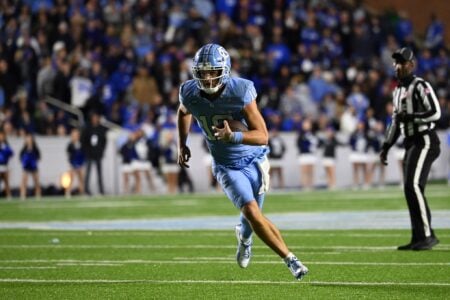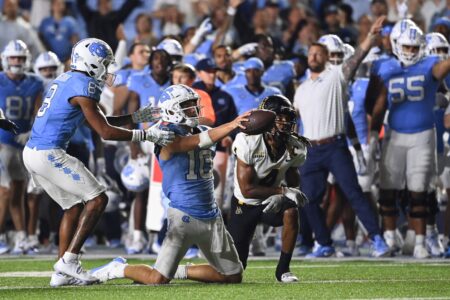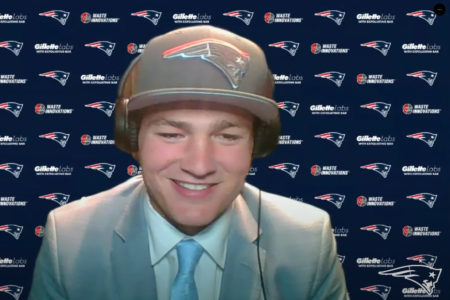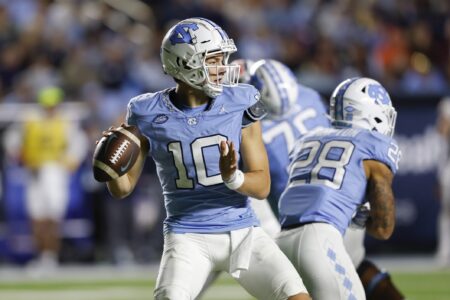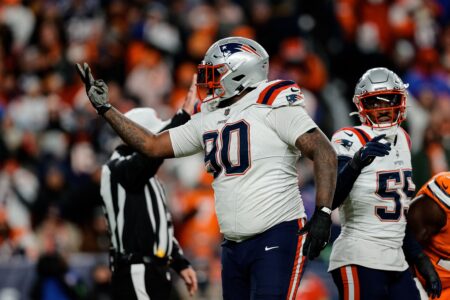PonyExpress
In the Starting Line-Up
- Joined
- Feb 12, 2006
- Messages
- 4,659
- Reaction score
- 78
Review of the 2003 Draft
What team really had the best draft in 2003? One way to figure that out is to use the Trade Value Chart. The Chart assigns a number, like a price, to every draft slot. When a team uses its pick it is an “expenseâ€. In theory each team goes into the draft with a “budget†of points, an unequal budget due to the inverse order of selection used by the NFL to promote parity.
Three years after the 2003 draft, how would the same players be redrafted? If we could rank them by real value, then we could assign a new “point value†to each player per the Trade Value Chart. By adding up the new “real values†of each team’s old picks, we could then figure out which teams got the most total value out of the draft, and which had the best net value. That should tell us which teams were helped most by the 2003 draft, and which teams draft best.
Assumptions.
1. The Trade Value Chart, which NFL teams use as a guide for transactions during the NFL Draft, assigns a reasonable relative value to draft picks.
2. It usually takes about three years after a draft to judge the real value of an NFL player. There are notable exceptions, but by and large the “three year rule†holds true.
3. The 2006 Sporting News Scouting Guide is a respectable publication and its player rankings and grading system are more carefully considered than the opinions of average fans.
Terms
Trade Value Chart: The chart designed by Jimmy Johnson and adopted as a guide by most NFL teams. Used to facilitate transactions involving draft picks. Values are assigned to each draft position on a diminishing scale. http://www.nfl.com/draft/story/6330687
Draft Day Value: draft day values assigned to a team’s draft picks, according to the Trade Value Chart.
Total Draft Day Value: The sum of a team’s individual draft day values.
Real Value: The actual value of a player 3 years after being drafted. This real value is achieved by ranking players of a given draft 3 years later, using the Sporting News Scouting Guide grading system, and then assigning a point value to those players according to the Trade Value Chart. Note: When players are tied in TSN’s grading system, the tie is broken in the following order of priority (1) QB (2) DE (3) CB (4) OT (5) WR (6) DT (7) RB (8) LB (9) TE (10) OG/C (11) S (12) K (13) FB
Total Real Value: The sum of a team’s individual real values
Net Real Value: Total Real Value minus Total Draft Day Value
I. The 2003 Draft
Here are all 262 selections of the 2003 draft, in order: http://www.nfl.com/draft/history/years/2003
II. Total Draft Day Value by team
Here were the 2003 draft picks per team, with individual draft day values and total draft value:
1. Cincinnati: 1 (3000), 33(580), 65(265), 98(108), 118(58), 136(38), 174(21.8), 215(5.4)= 4076.2
2. Detroit: 2(2600), 34(560), 66(260), 99(104), 137(37.5), 144(34), 175(21.4), 216(5), 220(3.4), 236(1), 260(1)=3627.3
3. Houston: 3(2200), 41(490), 67(255), 75(215), 88(150), 101(96), 192(14.6), 214(5.8), 217(4.6), 233(1)=3432
4. Chicago: 14(1100), 22(780), 35(550), 68(250), 100(100), 116(62), 139(36.5), 143(34.5), 171(23), 191(15), 206(9), 261(1)=2961
5. Dallas: 5(1700), 38(520), 69(245), 103(88), 178(20.2), 186(17), 219(3.8)=2594
6. Balt: 10(1300), 19(875), 77(205), 109(76), 134(39), 146(33), 182(18.6), 223(2.3), 250(1), 258(1)=2550.9
7. Ariz: 17(950), 18(900), 54(360), 70(240), 141(35.5), 177(20.6), 210(7.4)=2513.5
8. Jacksonville: 7(1500), 39(510), 72(230), 104(86), 132(40), 176(21), 179(19.8), 193(14.2), 218(4.2)=2425.2
9. NO: 6(1600), 37(530), 86(160), 102(92), 155(29.4), 203(10.2), 231(1)=2422.6
10. NYJ: 4(1800), 53(370), 85(165), 140(36), 150(31.4), 200(11.4), 237(1)=2414.8
11. Carolina: 8(1400), 50(400), 76(210), 82(180), 119(56), 145(33.5), 247(1)=2280.5
12. NE: 13(1150), 36(540), 45(450), 120(54), 164(25.8), 201(11), 234(1), 239(1), 243(1)=2233.8
13. Minn: 9(1350), 40(500), 71(235), 105(84), 180(19.4), 190(15.4), 221(3)=2206.8
14. StL: 12(1200), 43(470), 74(220), 106(82), 107(80), 148(32.2), 170(23.4), 172(22.6), 184(17.8), 251(1), 254(1)=2150
15. Seattle: 11(1250), 42(480), 73(225), 110(74), 165(25.4), 183(18.2), 224(2)=2074.6
16. Oakland: 31(600), 32(590), 63(276), 83(175), 96(116), 129(43), 167(24.6), 204(9.8), 246(1), 262(1)=1836.4
17. SD: 30(620), 46(440), 62(284), 80(190), 112(70), 149(31.8), 188(16.2), 229(1)=1653
18. Phil: 15(1050), 61(292), 95(120), 131(41), 185(17.4), 244(1)=1521.4
19. Denver: 20(850), 51(390), 108(78), 114(66), 128(44), 157(28.6), 158(28.2), 194(13.8), 227(1), 235(1)=1500.6
20. Cleve: 21(800), 52(380), 84(170), 115(64), 142(35), 152(30.6), 195(13.4)=1493
21. Buff: 23(760), 48(420), 94(124), 111(72), 127(45), 151(31), 187(16.6), 228(1)=1469.6
22. Pitt: 16(1000), 59(310), 125(47), 163(26.2), 242(1)=1384.2
23. Indy: 24(740), 58(320), 90(140), 122(50), 138(37), 162(26.6), 198(12.2), 208(8.2)=1334
24. SF: 26(760), 57(330), 89(145), 124(48), 161(27), 197(12.6), 241(1)=1323.6
25. NYG: 25(720), 56(340), 91(136), 123(49), 160(27.4), 199(11.8), 207(8.6), 211(7), 240(1), 249(1), 255(1)=1302.8
26. KC: 27(680), 47(430), 113(68), 153(30.2), 189(15.8), 230(1), 252(1)=1226
27. Ten: 28(660), 60(300), 93(128), 126(46), 154(29.8), 225(1)=1164.8
28. GB: 29(640), 79(195), 147(32.6), 166(25), 212(6.6), 245(1), 253(1), 256(1), 257(1)=903.2
29. Miami: 49(410), 78(200), 87(155), 156(29), 169(23.8), 181(19), 209(7.8), 213(6.2), 248(1)=851.8
30. Wash: 44(460), 81(185), 232(1)=646
31. TB: 64(270), 97(112), 133(39.5), 168(24.2), 205(9.4)=455.1
32. Atl: 55(350), 121(52), 196(13), 202(10.6), 238(1)=426.6
What team really had the best draft in 2003? One way to figure that out is to use the Trade Value Chart. The Chart assigns a number, like a price, to every draft slot. When a team uses its pick it is an “expenseâ€. In theory each team goes into the draft with a “budget†of points, an unequal budget due to the inverse order of selection used by the NFL to promote parity.
Three years after the 2003 draft, how would the same players be redrafted? If we could rank them by real value, then we could assign a new “point value†to each player per the Trade Value Chart. By adding up the new “real values†of each team’s old picks, we could then figure out which teams got the most total value out of the draft, and which had the best net value. That should tell us which teams were helped most by the 2003 draft, and which teams draft best.
Assumptions.
1. The Trade Value Chart, which NFL teams use as a guide for transactions during the NFL Draft, assigns a reasonable relative value to draft picks.
2. It usually takes about three years after a draft to judge the real value of an NFL player. There are notable exceptions, but by and large the “three year rule†holds true.
3. The 2006 Sporting News Scouting Guide is a respectable publication and its player rankings and grading system are more carefully considered than the opinions of average fans.
Terms
Trade Value Chart: The chart designed by Jimmy Johnson and adopted as a guide by most NFL teams. Used to facilitate transactions involving draft picks. Values are assigned to each draft position on a diminishing scale. http://www.nfl.com/draft/story/6330687
Draft Day Value: draft day values assigned to a team’s draft picks, according to the Trade Value Chart.
Total Draft Day Value: The sum of a team’s individual draft day values.
Real Value: The actual value of a player 3 years after being drafted. This real value is achieved by ranking players of a given draft 3 years later, using the Sporting News Scouting Guide grading system, and then assigning a point value to those players according to the Trade Value Chart. Note: When players are tied in TSN’s grading system, the tie is broken in the following order of priority (1) QB (2) DE (3) CB (4) OT (5) WR (6) DT (7) RB (8) LB (9) TE (10) OG/C (11) S (12) K (13) FB
Total Real Value: The sum of a team’s individual real values
Net Real Value: Total Real Value minus Total Draft Day Value
I. The 2003 Draft
Here are all 262 selections of the 2003 draft, in order: http://www.nfl.com/draft/history/years/2003
II. Total Draft Day Value by team
Here were the 2003 draft picks per team, with individual draft day values and total draft value:
1. Cincinnati: 1 (3000), 33(580), 65(265), 98(108), 118(58), 136(38), 174(21.8), 215(5.4)= 4076.2
2. Detroit: 2(2600), 34(560), 66(260), 99(104), 137(37.5), 144(34), 175(21.4), 216(5), 220(3.4), 236(1), 260(1)=3627.3
3. Houston: 3(2200), 41(490), 67(255), 75(215), 88(150), 101(96), 192(14.6), 214(5.8), 217(4.6), 233(1)=3432
4. Chicago: 14(1100), 22(780), 35(550), 68(250), 100(100), 116(62), 139(36.5), 143(34.5), 171(23), 191(15), 206(9), 261(1)=2961
5. Dallas: 5(1700), 38(520), 69(245), 103(88), 178(20.2), 186(17), 219(3.8)=2594
6. Balt: 10(1300), 19(875), 77(205), 109(76), 134(39), 146(33), 182(18.6), 223(2.3), 250(1), 258(1)=2550.9
7. Ariz: 17(950), 18(900), 54(360), 70(240), 141(35.5), 177(20.6), 210(7.4)=2513.5
8. Jacksonville: 7(1500), 39(510), 72(230), 104(86), 132(40), 176(21), 179(19.8), 193(14.2), 218(4.2)=2425.2
9. NO: 6(1600), 37(530), 86(160), 102(92), 155(29.4), 203(10.2), 231(1)=2422.6
10. NYJ: 4(1800), 53(370), 85(165), 140(36), 150(31.4), 200(11.4), 237(1)=2414.8
11. Carolina: 8(1400), 50(400), 76(210), 82(180), 119(56), 145(33.5), 247(1)=2280.5
12. NE: 13(1150), 36(540), 45(450), 120(54), 164(25.8), 201(11), 234(1), 239(1), 243(1)=2233.8
13. Minn: 9(1350), 40(500), 71(235), 105(84), 180(19.4), 190(15.4), 221(3)=2206.8
14. StL: 12(1200), 43(470), 74(220), 106(82), 107(80), 148(32.2), 170(23.4), 172(22.6), 184(17.8), 251(1), 254(1)=2150
15. Seattle: 11(1250), 42(480), 73(225), 110(74), 165(25.4), 183(18.2), 224(2)=2074.6
16. Oakland: 31(600), 32(590), 63(276), 83(175), 96(116), 129(43), 167(24.6), 204(9.8), 246(1), 262(1)=1836.4
17. SD: 30(620), 46(440), 62(284), 80(190), 112(70), 149(31.8), 188(16.2), 229(1)=1653
18. Phil: 15(1050), 61(292), 95(120), 131(41), 185(17.4), 244(1)=1521.4
19. Denver: 20(850), 51(390), 108(78), 114(66), 128(44), 157(28.6), 158(28.2), 194(13.8), 227(1), 235(1)=1500.6
20. Cleve: 21(800), 52(380), 84(170), 115(64), 142(35), 152(30.6), 195(13.4)=1493
21. Buff: 23(760), 48(420), 94(124), 111(72), 127(45), 151(31), 187(16.6), 228(1)=1469.6
22. Pitt: 16(1000), 59(310), 125(47), 163(26.2), 242(1)=1384.2
23. Indy: 24(740), 58(320), 90(140), 122(50), 138(37), 162(26.6), 198(12.2), 208(8.2)=1334
24. SF: 26(760), 57(330), 89(145), 124(48), 161(27), 197(12.6), 241(1)=1323.6
25. NYG: 25(720), 56(340), 91(136), 123(49), 160(27.4), 199(11.8), 207(8.6), 211(7), 240(1), 249(1), 255(1)=1302.8
26. KC: 27(680), 47(430), 113(68), 153(30.2), 189(15.8), 230(1), 252(1)=1226
27. Ten: 28(660), 60(300), 93(128), 126(46), 154(29.8), 225(1)=1164.8
28. GB: 29(640), 79(195), 147(32.6), 166(25), 212(6.6), 245(1), 253(1), 256(1), 257(1)=903.2
29. Miami: 49(410), 78(200), 87(155), 156(29), 169(23.8), 181(19), 209(7.8), 213(6.2), 248(1)=851.8
30. Wash: 44(460), 81(185), 232(1)=646
31. TB: 64(270), 97(112), 133(39.5), 168(24.2), 205(9.4)=455.1
32. Atl: 55(350), 121(52), 196(13), 202(10.6), 238(1)=426.6





